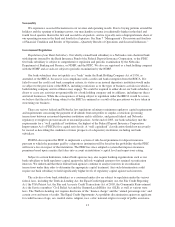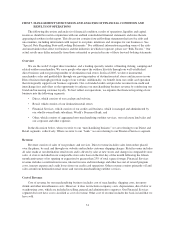Cabela's 2005 Annual Report Download - page 33
Download and view the complete annual report
Please find page 33 of the 2005 Cabela's annual report below. You can navigate through the pages in the report by either clicking on the pages listed below, or by using the keyword search tool below to find specific information within the annual report.• increase the total cost of our products to our customers relative to our competitors that do not collect use
taxes; and
• decrease the sales of our direct business or cause us to reduce the underlying prices for the products sold
through our direct business.
These events could have an adverse effect on the profitability and cash flows of our direct business.
We must successfully order and manage our inventory to reflect customer demand and anticipate
changing consumer preferences and buying trends or our revenue and profitability will be adversely
affected.
Our success depends upon our ability to successfully manage our inventory and to anticipate and respond to
merchandise trends and customer demands in a timely manner. We cannot predict consumer preferences with
certainty and they may change over time. We usually must order merchandise well in advance of the applicable
selling season. The extended lead times for many of our purchases may make it difficult for us to respond rapidly
to new or changing product trends or changes in prices. If we misjudge either the market for our merchandise or
our customers’ purchasing habits, our revenue may decline significantly and we may not have sufficient
quantities of merchandise to satisfy customer demand or we may be required to mark down excess inventory,
either of which would result in lower profit margins. In addition, as we implement our destination retail store
expansion strategy, we will need to construct additional distribution centers or expand the size of our existing
distribution centers to support our growing number of destination retail stores. If we are unable to find suitable
locations for new distribution centers or to timely integrate new or expanded distribution centers into our
inventory control process, we may not be able to deliver inventory to our destination retail stores in a timely
manner which could have an adverse effect on the revenue and cash flows of our retail business.
A natural disaster or other disruption at our distribution centers or return facility could cause us to
lose merchandise and be unable to effectively deliver to our direct customers and destination retail stores.
We currently rely on distribution centers in Sidney, Nebraska, Mitchell, South Dakota, Prairie du Chien,
Wisconsin and Wheeling, West Virginia to handle our distribution needs. We operate a return center in Oshkosh,
Nebraska, and our Wheeling, West Virginia distribution center also processes returns. Any natural disaster or
other serious disruption to these centers due to fire, tornado or any other calamity could damage a significant
portion of our inventory, and materially impair our ability to adequately stock our destination retail stores, deliver
merchandise to customers and process returns to vendors and could result in lost revenue, increased costs and
reduced profits.
We are implementing substantial systems changes in support of our direct business and destination
retail store expansion that might disrupt our supply chain operations.
Our success depends on our ability to source merchandise efficiently through appropriate management
information and operational systems and procedures. We are implementing modifications to our technology that
will involve updating or replacing our systems with successor systems during the course of several years,
including changes to our warehouse management and merchandising systems and improvements to our customer
relationship management system. There are inherent risks associated with replacing or modifying these systems,
including supply chain disruptions that could affect our ability to deliver products to our stores and our
customers. We may be unable to successfully launch these new systems, the launch of these new systems could
result in supply chain disruptions or the actual cost may exceed the estimated cost of these new systems, each of
which could have an adverse effect on our revenue and profitability.
21
























